The new ASUS ROG Phone 6 series: Everything you need to know, and more

ASUS Republic of Gamers (ROG) has today revealed their new ROG Phone 6 series of gaming smartphones, along with new models in the ROG Cetra series of true wireless gaming headphones and ROG Delta series of gaming headsets.
In the same launch, a collection of ROG Phone 6 accessories was revealed to elevate user experience.
Getting into the most-anticipated products of this launch, the ROG Phone 6 series includes the ROG Phone 6 and ROG Phone 6 Pro.
Here are their main specs:
| Phone | ROG Phone 6 | ROG Phone 6 Pro |
|---|---|---|
| Body | Equipped with Aura RGB lighting on the back | Features a colour ROG Vision mini-display on the back |
| Display | – 6.78-inch Samsung AMOLED HDR10+ – 165 Hz refresh rate – 720 Hz touch-sampling rate – 23 ms ultra-low touch latency |
– 6.78-inch Samsung AMOLED HDR10+ – 165 Hz refresh rate – 720 Hz touch-sampling rate – 23 ms ultra-low touch latency |
| Memory | – 12GB + 256GB – 16GB + 512GB |
18GB + 512GB |
| Camera | – Flagship Sony IMX766 50 MP main wide-angle – Ultrawide 13 MP second camera – Macro camera – 12 MP front camera – HDR10+ Video Mode |
– Flagship Sony IMX766 50 MP main wide-angle – Ultrawide 13 MP second camera – Macro camera – 12 MP front camera – HDR10+ Video Mode |
| Chipset | Snapdragon 8+ Gen 1 | Snapdragon 8+ Gen 1 |
| Battery | 6,000mAh | 6,000mAh |
| Colours | – Phantom Black – Storm White |
Storm White |
To elaborate on some of these specs, the latest flagship Snapdragon 8+ Gen 1 is equipped with a full suite of Snapdragon Elite Gaming features plus an improved Qualcomm Adreno GPU.

In fewer words, these are supposed to offer an increased performance improvement compared to the Snapdragon 888 that powered the ROG Phone 5.
With regards to the ROG Phone 6 series’ refresh rate, it can be set to 60Hz, 90Hz, 120Hz, 144Hz, or 165Hz for the ideal gaming experience.

Complementing this are visuals that have been tuned in collaboration with Pixelworks for great colour accuracy.
Though this new series of phones again have a monster of a 6,000mAh battery, charging times shouldn’t be a pain thanks to a 65-watt HyperCharge adapter.

Of course, this section on the phones can’t end without highlighting several other features that add to one’s gaming experience.
ASUS has made significant upgrades to the AirTrigger 6, and the ultrasonic sensors now fully support various gestures including new features such as Dual Action, Press and Lift, and Gyroscope Aiming.
These should enhance one’s gaming experience across various genres, perhaps most noticeably in first-person shooters (FPS), with the 720 Hz touch-sampling rate and 23 ms ultra-low touch latency only making gaming sessions better.

When it comes to long hours of gaming, heat buildup becomes a real issue, and on the ROG Phone 6 series, there’s an upgraded GameCool 6 cooling system that comes to the rescue.
It includes a 360-degree CPU cooling technology, a larger vapour chamber, larger graphite sheets, along with a centred-CPU design to increase heat dissipation from the core.
Combined with the new performance manager in Armoury Crate, the ROG Phone 6 series allows gamers to fine-tune performance settings for different games.

In terms of audio, the GameFX audio system on ROG Phone 6 features symmetrical seven-magnet dual speakers, with sound that’s been optimised in collaboration with Swedish digital audio pioneer Dirac.
The Dirac Virtuo spatial audio solution enables immersive stereo sound, while Snapdragon Sound technology ensures super-low latency processing for lag-free gaming and lossless music streaming.
For those who still love their good old wired headphones, there’s a 3.5mm headphone jack on the phones.
Speaking of wired headphones…
ASUS also revealed a range of new wireless and wired headphones. The ROG Cetra True Wireless Pro is a wired/wireless dual-mode model featuring an ESS Quad DAC and an AI noise-cancelling microphone for crisp in-game audio and communication.

With the AI noise-cancelling microphone, background noises such as chatter, keyboard clatter, and mouse clicks are effortlessly filtered out when on a call.
The ROG Cetra True Wireless is a purely wireless model.

On the other hand, the brand-new ROG Delta S Wireless is the first ROG dual-mode wireless gaming headset. It can be used in either 2.4GHz or Bluetooth modes for maximum flexibility when connecting devices.

AI noise cancellation is available on this pair too with concealed AI beamforming microphones. Finally, there’s also the new ROG Delta S Core, which is a lightweight 270g headset designed with comfort as a priority.
Accessorise to optimise
Accessories revealed include the AeroActive Cooler 6, ROG Kunai 3 Gamepad for the ROG Phone 6 series, ROG Phone 6 Glass Screen Protector, cases, and more.

The clip-on AeroActive Cooler 6 has an AI-powered thermoelectric cooler, and a fan that delivers increased cooling airflow directly to hotspots on the back cover of the ROG Phone 6.

According to ASUS, the result is that it can lower the surface temperature by up to a 25°C. The AeroActive Cooler 6 also adds four extra physical buttons to allow a genuine console-like control experience.
-//-
If you’re game on for the ROG Phone 6 series, both variants of the ROG Phone 6 will be available in Malaysia starting from August 2022. The 12GB + 256GB variant is priced at RM3,599, while the 16GB + 512GB one will be priced at RM4,399.
The ROG Phone 6 Pro will be priced at RM4,999, and is available in Malaysia starting from September 2022.
Pre-orders for the ROG Phone 6 will commence on July 6, 2022 on Shopee and offline channels, with RM548 worth of early bird freebies, comprising of a one-year warranty extension (worth RM199) and an AeroActive Cooler 6 (worth RM349).
On top of that, pre-orders of the ROG Phone 6 on Shopee will also be entitled to 10% off on the ROG Slash Hip Bag and ROG Slash Crossbody Bag, which are priced at RM499 and RM399, respectively.
- Learn more about ASUS ROG products here, and stay tuned for more updates here.
- Read our latest review on the ASUS Zenbook Pro 14 Duo OLED laptop here.
Also Read: Axdif: An HR management platform that solves communication, planning, & productivity issues
S’pore startup treatsure co-creates pop-up store at Woodlands MRT to encourage zero food waste
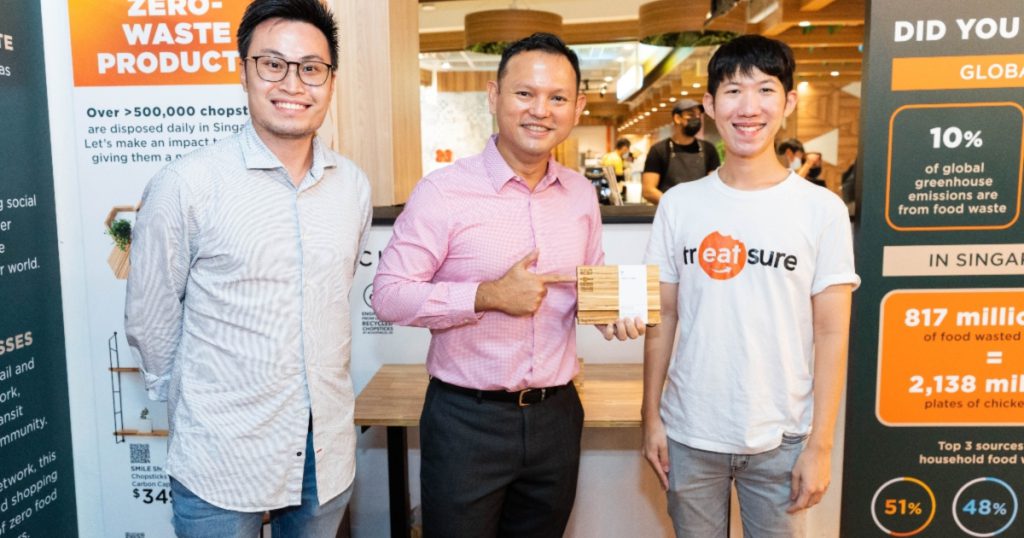
In a bid to encourage zero food waste and shed light on the problem of food surplus, Stellar Lifestyle, treatsure, and DBS Foundation launched ‘ZERO by treatsure’.
ZERO marks the first collaboration between Stellar Lifestyle, a business arm of SMRT, DBS Foundation, and treatsure, Singapore’s leading mobile app for surplus food from hotels and grocers, in support of Singapore’s drive towards zero waste.
This pop-up store is located at the Stellar@TE2 retail zone of Woodlands MRT station, and is the first of its kind within Singapore’s rail transit network to blend sustainability education with retail innovation to promote zero food waste.
ZERO is open daily from 7am to 10pm until 31 July 2022, following which, it will move to Esplanade MRT station from 1 August to 30 September 2022.
Shopping with a sustainable mindset
The key highlight of the ZERO space is its novel offline-to-online shopping experience that allows the public a hassle-free way to buy surplus groceries on the treatsure app at discounted prices.

Commuters simply have to scan QR codes on a three-dimensional (3D) designed wall that resembles a supermarket shelf, purchase their groceries on their phone, and arrange for delivery to their homes. Alternatively, they can pick up their purchases at the ZERO installation.
treatsure’s ZERO space categorises food items according to common sources of food wastage: expiring, imperfect, and excess. This displays a different perspective to grocery shopping, allowing consumers to learn more about real-world statistics on food wastage and the challenges.

Additionally, ZERO also introduces the public to other sustainability concepts. The sustainable food and merchandise section presents a range of zero-waste alternatives consumers can consider as part of their consumption.
These products include beeswax wraps, home composting bins, plant-based milk and upcycled drinks from surplus ingredients. Upcycled chopstick furniture and products from zero-waste partner ChopValue Singapore are also featured in this mini exhibition.
Together, Stellar Lifestyle, treatsure, and DBS Foundation hope to bring a greater awareness of zero food waste to the public, as well as drive positive change in support of the SG Green Plan.
Featured Image Credit: Stellar Lifestyle
Also Read: Don’t Waste Food: Their App Lets You ‘Dabao’ Buffet Food For S$10, Buy Cheap Surplus Grocery
This S’porean built a sustainable marketplace – sells plantable candles to help reforestation
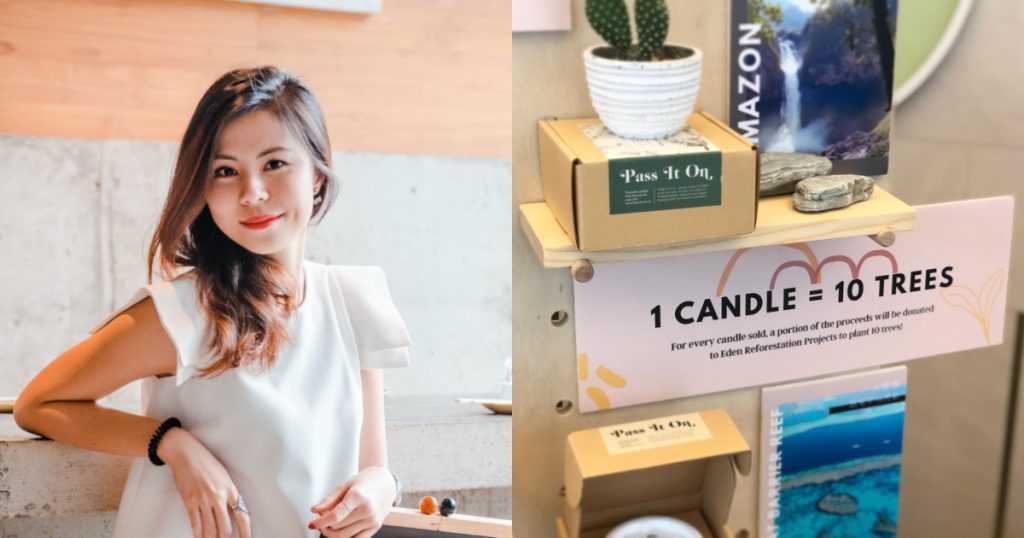
Singapore’s lifestyle brand, Pass It On, is committed to making sustainable urban living a necessity. Its mission is to pass on a sense of consciousness in our daily choices, big or small, through its range of home and living products.
Founder Michelle Chow first had a revelation during a trip to Lady Elliot Island — the southernmost island of the Great Barrier Reef — which kickstarted her journey in sustainability.
“I saw the contrast between healthy, thriving corals, and bleached corals. It then dawned on me that my then four-year-old niece might not be able to see the breathtaking reefs when she’s of age to dive,” says Michelle.
This sparked the idea of a sustainable venture, now known as Pass It On. Stemming from a long and successful career in fashion, marketing and events, her career transition surprised many.
In fact, her stint in fashion played a role in her decision to champion climate action. She saw firsthand how fashion could be polluting — with research proving that the fashion industry is the second largest polluter in the world after the oil industry — so she wanted to make a difference.
Inspired by half-finished candles
Pass It On first started out as a side project. Reading up on climate change encouraged Michelle to start a fundraising project on Kickstarter to plant trees in 2020.
The project raised five times the funding goal, further prompting her to start Pass It On in 2019, a brand that would continue to give back.
Unfortunately, the COVID-19 pandemic hit soon after its launch. This was why Michelle continued pursuing Pass It On as a mere side project, while consulting for brands and advertising agencies at the same time.
It was only in April 2021 when she turned the sustainable brand into a full-time project.

Pass It On soon became recognised for its plantable candles, a best-seller and a product unique to the brand. This idea first came to her when she brainstormed ideas to further fuel the tree-planting fundraiser.
I looked around my house and saw multiple candles lying around half-finished. I started taking classes on how to make my own. When it came to deciding what vessel to use for the candles, I saw the half-finished candles in my home and thought: what if the vessels could be given a second life?
– Michelle Chow, founder of Pass It On
Building on the idea of a second-life candle, Michelle jumped into the design process, with an aim to make the end product as low-waste as possible.
A business model of eco-friendly practices
Although the pandemic might have put a damper in the brand’s expansion plans, it did not faze Michelle.
Instead of opening a permanent physical store, she pivoted and launched a pop-up store instead, as well as pushed to distribute Pass It On’s products across various brick-and-mortar stores in Singapore.
To be an entrepreneur, you have to be comfortable with change, especially for a business that really grew during the COVID-19 period. Our brand mission is focused around making sustainable living a necessity in people’s lives.
Though we remain focused on the bigger goal, there are countless ways to be creative about the process and the approach. We grow, with the flow.
– Michelle Chow, founder of Pass It On
Michelle’s passion for sustainability reflects clearly within her business practices. On the business front, the Pass It On team pushes out social media content on various environmental issues. She also taps on her team’s interest and background for them to run certain projects.
“We had an intern who was from the National University of Singapore (NUS)’s Environmental Studies faculty. She had a wealth of knowledge on our natural environment. Together, we kickstarted a series of Conscious Tours where we brought people on local nature walks at Clementi and MacRitchie forest.”
Michelle also acknowledges that over-packaging is one of the biggest problems when it comes to consumer goods. The brand calls for new packaging seasonally, but Michelle has found a creative way to get around this issue.

“When we wanted to make a special gift wrap for Christmas, we opted for upcycled fabric Furoshiki wraps. We also created gift box sleeves that double up as greeting cards to minimise the use of paper and tape,” shares Michelle.
“At all our pop-ups and events, we reuse paper bags given to us by our community. It doesn’t matter that we forewent a branding opportunity on our shopping bags. Instead, we repurposed 545 bags through this exercise.”
Passion for educating and advocating
Aside from being an entrepreneur, Michelle knows the best way to make a mark is to lead by example and keep the eco-conscious habits going — be it at work or at home.
At home, she sorts her waste into categories for recycling and food scraps for compost. Michelle also uses eco-friendly cleaning tablets, upcycles all her cleaning spray bottles, and recommends recyclable tissue paper. Her household also utilises solar-powered electricity.
Her passion to educate and make a mark on sustainability is ignited by various factors: the existence of fast fashion, overproduction and consumption, recent findings from the Intergovernmental Panel on Climate Change (IPCC) report, and the debate on whether to remove the Great Barrier Reef from UNESCO’s list of world heritage sites.
Although Pass It On is a growing work-in-progress that is continuously developing and innovating, Michelle says that the brand will persist in three focal areas.

Firstly, Pass It on aims to be an innovator, where they further design their own products, such as the plantable candles. Secondly, as a retailer, they have the ability to source and curate like-minded brands from different parts of the world and sell them on their platforms.
Lastly, Pass It On serves as an advocator, where they conduct events, talks, and workshops with corporate clients and hold their own flagship events.
For instance, Pass It On is hosting its first immersive physical and digital retail experience for sustainable home and lifestyle brands from 23 to 24 July 2022.
Called ‘GREEN-HOUSE’, the event is a way for attendees to discover other local businesses who prioritise sustainability and positive social impact in the way they operate. Participating local businesses include homegrown coffee technology company Morning, Furniche+, Re-store, and textile artist Natalia Weaves, just to name a few.
Guests can also learn how to upcycle, compost, mend and create useful items in line with a low-carbon-footprint lifestyle during the event workshops. In addition, GREEN-HOUSE will contribute one planted tree to Pass It On’s long-term NGO partner for every attendee.
Sustainability efforts for the future
Pass It On’s plans for the future include continuing its collaboration with the Eden Reforestation Project, with an aim to hit the goal of planting one million trees.

With every purchase of a Pass It On candle, a donation is made to the Eden Reforestation Project, allowing for the planting of 10 trees. Since 2020, Pass It On has contributed to 132,967 planted trees, with an aim to reach 250,000 by the end of this year.
“Instead of splitting its energy and resources across different beneficiaries, we’ve chosen to focus on the Eden Reforestation Project so we can channel all our energy and resources to this mission and meet our goal,” says Michelle.
Featured Image Credit: Pass It On
Also Read: Sustainable lithium? This S’pore startup gives used EV batteries a ‘NEU’ life by recycling them
Alchemy Pay CEO believes crypto and Web3 will continue to grow despite market decline
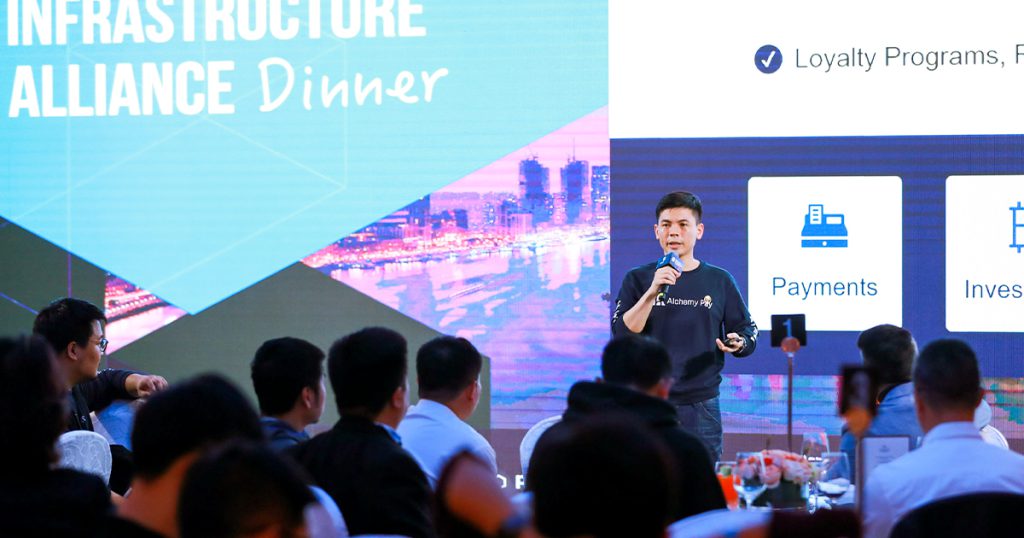
For most users, cryptocurrency serves as the gateway to blockchain technology. In fact, newcomers may even be under the impression that the two are synonymous. In reality, blockchain has a lot more to offer, with utilities in a number of industries apart from finance.
“What crypto has given us is a platform to talk more about the blockchain technology that underpins it,” says John Tan, CEO of Alchemy Pay.
“As organisations find more ways to apply and integrate blockchain technology in everyday life, I believe people will start to realise that it does more than just power cryptocurrencies.”
With this in mind, Alchemy Pay is approaching blockchain adoption from a new angle — one where crypto doesn’t need to be the cornerstone. With its payment solutions, the company is helping make blockchain services more accessible to those using fiat.
What does blockchain offer besides crypto?
As it stands, NFTs have become a popular use case for blockchain technology. At the Point Zero forum last month, Binance CEO Changpeng Zhao spoke about their high potential for the future. He stated that a lot of people are now entering this space solely to purchase NFTs, and not cryptocurrency.
Tan concurs with this idea, adding that there are so many possible applications.
Although NFTs have garnered a lot of attention in the art and entertainment world, they are now evolving beyond it. We are already seeing real-world applications for NFTs such as proof of ownership in real estate, supply chain tracking, ticketing, ensuring the authenticity of products, and much more.
– John Tan, CEO of Alchemy Pay
Along with NFTs, the metaverse is another area which is evolving rapidly. “Building metaverses on decentralised Web3 platforms allows for more freedom of development,” says Tan.
Top metaverse projects such as Decentraland and The Sandbox have a market cap exceeding US$1 billion today.

Mainstream brands have begun entering the space too, participating in events such as Metaverse Fashion Week. This year’s iteration featured a virtual runway show by Dolce & Gabbana, and in-world stores set up by Selfridges, Tommy Hilfiger, and more.
Making blockchain services accessible
For mainstream consumers to participate in the metaverse or buy NFTs, they usually need to have knowledge of crypto.
They must purchase it on an exchange and then transfer it to a decentralised wallet. In case the right cryptocurrency isn’t listed on their exchange, they must also figure out how to swap it appropriately.
This entire process can seem unnecessarily complicated for someone who just wants to own an NFT. There are a lot of steps involved, and if one isn’t careful, they can end up losing their funds. For example, sending crypto to the wrong wallet address can make it irretrievable.
With its payment solutions, Alchemy Pay is working to simplify the Web3 onboarding process. “Our class-leading solutions provide direct, one step entry into the world of Web3,” says Tan.

“Using simple integration processes, our crypto on-ramps are easily included as direct or customisable plug-ins for Web3 services. We enable acceptance of mainstream fiat payment methods from users and convert them to the cryptocurrencies required to use Web3 services.”
This way, users are saved the time of manually converting their funds into crypto. “We aim to make the process of entering and exiting crypto and Web3 platforms as seamless as possible for all users — newcomers and experts alike.”
Alchemy Pay offers over 300 fiat payment channels, allowing users from all over the world to make use of its services. “We also allow users to exchange back to fiat currency and have their funds transferred to their bank accounts. This is real accessibility to web3.”
The future of Web3
The recent market crash has created doubts about the future of crypto and Web3. The market has seen a downtrend for over three months now, and experts such as Binance’s CEO have speculated that it could be years before we see recovery.
Despite this, Tan believes that the space is still primed for growth. Once again, it comes down to the fact that blockchain technology offers more than just crypto. There are other emerging services which are drawing in users, and this isn’t immediately reflected in the prices of different cryptocurrencies.
“There is a huge migration of talent from Web2 into Web3. We’re seeing many established brands now creating a division dedicated to driving Web3 strategy.
“There is a whole industry and economy that has been built up around Web3 and the idea of decentralisation. People are interested in learning more and participating regardless of crypto prices.”
Featured Image Credit: Alchemy Pay
Also Read: From Binance to Coinbase: These 10 crypto companies are currently hiring in S’pore
At 21, this Ipohrian began designing sarees. 2 yrs in, her pieces have found global buyers.

India is said to have one of the largest diasporas in the world. Yet in Malaysia, the Indian population only makes up about 6.8% as of 2020, according to our local Department of Statistics.
It’s no wonder that traditional Indian wear that also happens to be Malaysian-made is scarce.
One artisan filling this gap is Brinda Sagar, an Ipohrian who started her brand amidst the lockdowns at 21 years old.
With a keen interest in photography, one of her pastimes is Instagramming, as she puts it. This hobby would later aid her in gaining customers for her Indian wear business, The Sagar’s, which now has over 24,000 followers on Instagram at the time of writing.
Founded online
Raised by shop owner parents in Ipoh, Perak, Brinda has been exposed to a business environment from a very young age.
Nearing the end of her university journey in Professional Communications, the lockdowns were imposed, and she moved back to her hometown from KL.
“Time away from all the hustle and bustle of KL made me start a special Instagram page for my interest which included styling,” Brinda told Vulcan Post.
“The only available choice at that moment for me was to style Indian traditional attire as my parents were in this retail business for years.”

With the intention to inspire others through her styling abilities, Brinda’s Instagram page started gaining the attention of buyers as time went by.
Now, she reported that The Sagar’s has found customers from Malaysians, Singaporeans, and France-based Indian populations.
The right fit
Scrolling through The Sagar’s Instagram page, where most of the operations take place, the page specialises in sarees for women.
Though Malaysian-made Indian traditional dresses were rare to find several years ago, the craft is now slowly picking up its pace.
“There’s a wide variety of online Indian traditional clothing stores to choose from, especially after my brand got famous,” Brinda claimed.
The saree designer even stated that there have been several pages copying her designs and reselling them, something that seems unfortunately too common in the fashion world.
She elaborated that there are also some taking inspiration from her designs and creating modified versions of her dresses.

Yet, Brinda doesn’t let herself get too bothered by this. Perhaps it’s because she’s aware of The Sagar’s product-market fit, and her marketing abilities.
Aside from her strict curation of designs, customisation services are also available, where customers can request certain designs and choose their own saree colours. These factors are what Brinda believes makes The Sagar’s stand out amidst the competition.
“Everyone can buy my products because of the design. Our dresses mainly are long-sleeved-flair gowns,” she said. “The fact that you can customise your own dresses also opens up the possibility for other races to wear our clothing line according to their sense of style.”
Handmade to order

As the sarees are considered luxury items and are handmade, Brinda attributed her key business challenge to fulfilling customers’ demands on time.
Meeting special deadlines given by customers sometimes puts her in a dilemma as The Sagar’s requires at least four to six weeks to complete a single order from the day a request is made.
“It is important for our customers to be patient as there are a lot of intricacies involved in completing a designer Indian dress,” Brinda added.
When it comes to festivities, Brinda sets up pre-orders for her customers. To prepare for the influx of dresses to tailor, a portion of the work is outsourced to factories in India, especially for pieces that are in The Sagar’s ready stock.

Brinda shared that she faces little issue when it comes to styling her designs. “I just follow my style instincts and people seem to really like it,” Brinda pointed out.
Emphasising her sarees’ quality, Brinda occasionally finds it challenging to keep up to her own standards. “My business mantra is ‘quality over quantity’, [so] I complete a customer’s dress order as if it’s being made for me. In other words, I put myself in the shoes of my customers.”
Also believing that comfort should come before style, Brinda ensures her designs fit that bill. This particularly holds true with traditional Indian attire that can be uncomfortable due to a piece’s stoneworks and rough thread embroideries.
It seems that this attention to detail is working for Brinda. Reviews praising The Sagar’s product quality have been helping build customers’ trust towards the brand and Brinda’s abilities, which is noteworthy for a young entrepreneur who’s just getting started.
While Brinda has worked with customers from France, Canada, Singapore, and New Zealand, she stated that postage fees can be pricey.
Thus, she intends to first expand The Sagar’s brand in the local market, and is hoping to own a physical store for her clothing line down the road.
Also Read: Axdif: An HR management platform that solves communication, planning, & productivity issues
Featured Image Credit: Brinda Sagar, founder of The Sagar’s
Nature meets science: This S’porean used to suffer from acne so she built a clean skincare brand
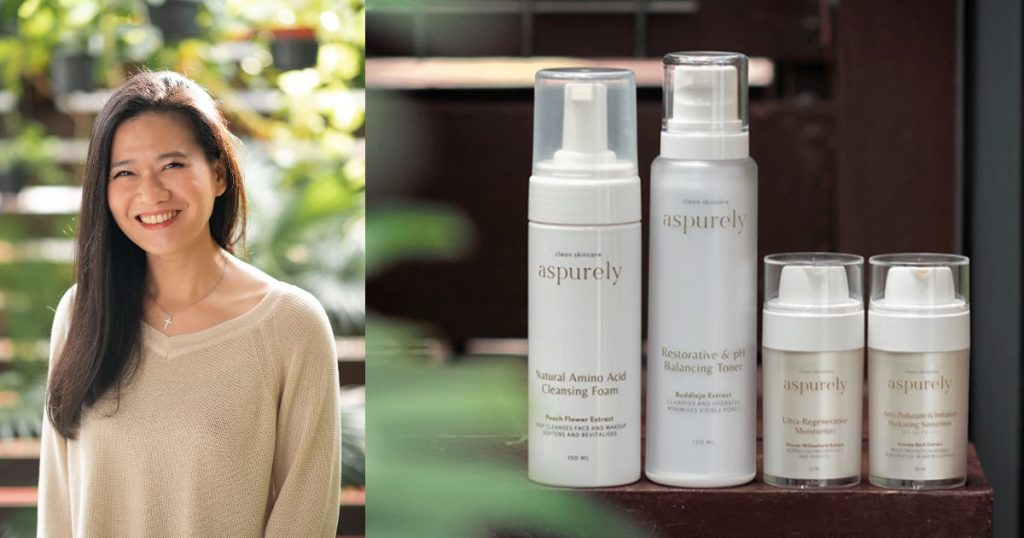
The subject of skincare has always been a personal one to Coreenna Ong, who used to experience severe outbreaks in her teenage years. In an effort to find a product that worked for her, she ended up experimenting with blends of herbs, which led to her fascination with nature.
Established in September 2021, aspurely — formerly known as Recherché — is an innovation-focused clean skincare brand inspired by nature and science, with a focus on the usage of pure, efficacious ingredients and formulas.
It aims to express the vision that beauty care can be clean, pure, holistic and high performance at the same time.
“[W]e would love for people to experience how our clean and pure formulas could deliver great results for their skin regardless of the skin concerns they may be facing,” shares Coreenna, co-founder and director of research and development (R&D) of aspurely.
Gaining knowledge and insights about skincare
Coreenna’s journey to founding aspurely was a long and treacherous, but fulfilling process.
She shares that she first met her business partner, who was in chemical manufacturing, in 1997 when she forayed into the skincare industry. In those early years, she visited farms in Europe, China, Korea and Taiwan to learn about harvesting and processing techniques.

With the help of her business partner, she managed to form extensive connections with a global network of scientists and laboratories, allowing her to gain more knowledge and insights into the scientific and technical aspects of formulation and quality control processes.
She then made the effort to apply her knowledge and educate others on skincare through her work, where she was a beauty columnist for Lianhe Zaobao, Singapore’s largest Chinese-language newspaper.
“As its weekly expert contributor, I shared the latest research and technologies from the beauty industry and addressed many readers’ skincare issues and concerns, offering beauty tips, quick fixes, and insider knowledge”.
She also authored two best-selling beauty and wellness books with Marshall Cavendish: Nature’s Spa: DIY Beauty Treatments and Nature’s Treats: Recipes for Wellness.
Through this journey, she noticed that some had the misconception that clean skincare is not as effective as conventional skincare because it is “too natural”.
This gap in understanding was what ultimately drove her to explore this business venture, in efforts to dispel the misconception by proving that clean skincare can be just as efficient.
Aspurely’s skincare philosophy: harmony and symphony
Aspurely believes that people are all born with pure, pristine skin.
However, people’s lifestyles eventually cause possible alterations in DNA, causing the skin to be in need of a remedy. The food that we consume, the amount of sleep earned, the amount of stress surrounding oneself, are some factors that can affect one’s skin health.
“While significant lifestyle habits are hard to change, taking small steps to care for our skin daily could go a long way in improving skin wellness,” says Coreenna.
She adds that by practising daily mindfulness and consciousness of what we give to our bodies such as skincare, the effects of environmental stressors can be mitigated in order to improve wellbeing.
In particular, aspurely’s skincare products contain active ingredients that can help control and regulate factors that affect epigenetics and skin quality, such as skin detox, renewal and repair cycles. They are also hypoallergenic, which helps avoid the trigger of skin allergies.
Their products rejuvenate the skin at the DNA level by reactivating key gene expression, fibroblasts stimulation and cellular defences that are needed to maintain the skin’s DNA at a healthy, optimal state.

aspurely seeks to provide one coherent, harmonious symphony of benefits to one’s skin through its clean products. According to Coreenna, they “tap on the art and science of synergy, where the sum of parts produce combined effects greater than the sum of their separate effects.”
Similar to how each type of herb used in Traditional Chinese Medicine have their own individual functions but play complementary roles to each other when combined, this synergy that aspurely incorporates into its skincare products seeks to attain an occurrence where formulas interact harmoniously to bring out the best in one another.
The final, fully combined formula would then be effective and beneficial to the user, restoring harmony and balance to the user’s body and mind.
“This is what synergy is all about — and this is the heartbeat of our formulation methodology and everything else we do at aspurely,” says Coreenna, adding that while there are key ingredients in each formula, there is no one “star” ingredient.
“To us, each ingredient we have carefully selected to be part of a formula is a star in its own right. Each ingredient has an important reason to be there — to work together with the other ingredients to ensure the final formula delivers the best results for you.”
With a unique philosophy on skincare, aspurely sets itself apart from other skincare brands, while also ensuring that only all-natural preservatives made from eco-certified botanicals and plants are used in formulas to eliminate microbial contamination and product safety.
The end product? Environmentally-friendly, cruelty-free, skin-friendly products that deliver visible results people are looking for.
Behind the scenes
Coreenna is passionately involved with R&D, and has 25 years of experience under her belt in skincare product development. She emphasises that products are thoroughly tested before entering markets.
Besides in-vitro tests and lab screening tests to ascertain the safety and efficacy of the ingredients, to make sure our products will deliver what they are created to deliver, they are tested on human volunteers for a period of three to six months where we gather quantitative and qualitative data and feedback.
Typically, the R&D process takes about [six] to [nine] months for each product, depending on the product type and the intended purpose of the product.
– Coreenna Ong, co-founder and director of R&D of aspurely

One of its best-selling product is the Natural Amino Acid Cleansing Foam, which does not have any low-cost sulfates and ingredients in its formulation.
Even though their products may be considered pricey (prices start from S$49 for a cleansing foam), product quality is assured. Their products make use of raw materials and actives from natural sources that follow stringent quality control and safety protocols.
“Many of the ingredients that we use are COSMOS and ECOCERT certified. As far as possible, we also choose materials that are organically produced. Such ingredients and materials do not come cheap, compared to mass-produced petroleum-based materials,” explains Coreenna.
Additionally, these sources are sustainability cultivated and processed using methods to ensure minimal carbon footprint. Product packaging is also made biodegradable to reduce environmental impact on the environment.
Challenges of being “made-in-Singapore”
Gaining consumer base and support proved to be challenging for aspurely. As a “made-in-Singapore” skincare brand, they had to compete against many bigger and international competitors.
She recalls that it was difficult to overcome consumer hesitancy as homegrown skincare brands were not popular among consumers.
People tend to trust established European, US or Japanese brands. It was an uphill task trying to get people to understand that made-in-Singapore skincare is no less superior.
I was even advised by many close associates to just label our products as ‘Made in France/USA/Japan’, for the sake of gaining easier consumer acceptance, especially [when we are] a new, unheard-of-brand. However, be it national pride or personal conviction, I refused to do that. Hence, it was a big challenge to overcome people’s mindsets.
– Coreenna Ong, co-founder and director of R&D of aspurely
Coreenna, who first ventured into the skincare industry in 1998, also notes that the prevalence of social media was not as strong as present times. Efforts to advertise were futile, for advertising campaigns of larger companies quickly overpowered theirs.
“[W]e had to start promoting within our own immediate family members, close friends and relatives and asked them to help spread the word,” she says. This method proved to be effective for them, as word-of-mouth advertising helped to build the idea that they were selling truly effective skincare products.

Eventually, people came to accept their skincare products as aspurely lived up to its name of delivering visible results.
“Today, more than 20 years later, it is heartening to see many other made-in-Singapore skincare brands making their mark on the global stage,” says Coreenna, adding that she was glad that she stuck to labelling aspurely as a homegrown brand.
Venturing into health and well-being
When COVID-19 hit, Coreenna mentioned that despite facing issues like the escalating cost of business operations and raw materials — with the latter increasing by as much as 20 per cent in the past two years — it enabled them to become more flexible through the decentralisation of their business operations and focusing on strengthening their website sales.
Despite the COVID challenges, Aspurely has been steadily growing. Some of the partners they have established partnerships with include KrisShop, Thomson Medical Centre, Mount Alvernia Hospital, Precious Medical Group, Zest Clinic and Balanced Living.
Sharing future business plans, Coreenna says that besides their topical and edible skincare, they are seeking to continue developing health and well-being products that are clean and free of additives and fillers.
Aspurely also plans to work with aesthetic clinics and holistic well-being centres, as they deem them as suitable channels in which they can share and spread their message of clean beauty and well-being in a systematic, interesting and educational way.
“We believe that beauty is more than skin deep. True beauty is something that radiates from within our innermost being. That means the health and well-being of our body and mind plays a big part too,” sums up Coreenna.
Shop aspurely now at VP Label:
[iframe_vp_product src="https://vulcanpost.com/label/embed-all/embed-aspurely/" id="iframe1"]
Featured Image Credit: aspurely
Also Read: Giving clothes a second life: How these S’pore brands are paving the way for sustainability
This M’sian ex-flight attendant runs her own edible flower farm with zero waste practices
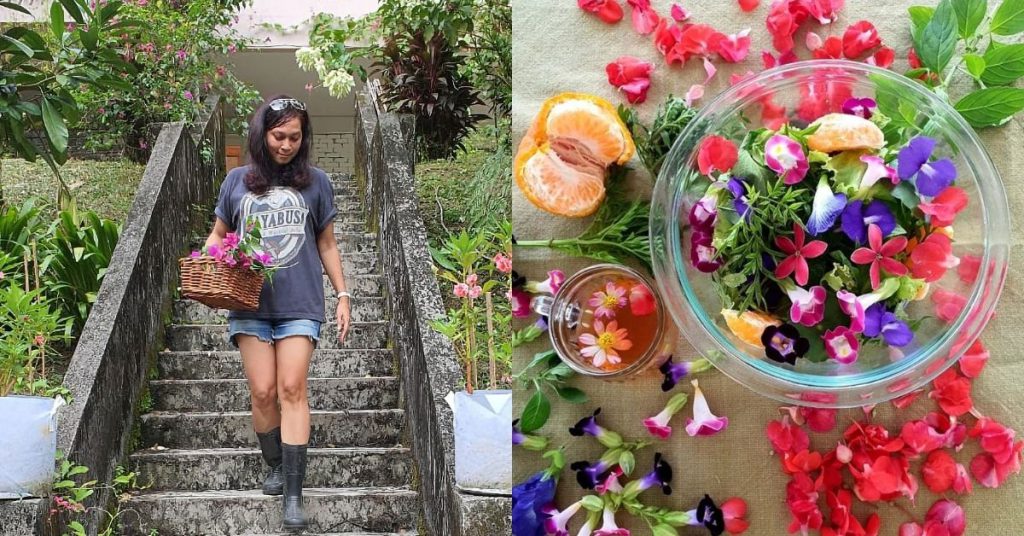
When she was a kid, Nur Evelyn Ghazali would go to Cameron Highlands with her family during the holidays. They would visit tea houses that doubled as flower farms, which greatly fascinated Evelyn.
“I told myself I would own a flower farm one day,” she said to Vulcan Post.
Before she got to that point, Evelyn first became a flight attendant. This took her to beautiful places around the world but had nothing to do with farming.
In fact, she was supposed to stay out of the sun to keep her skin fair and free of freckles.

Like many others, though, the pandemic proved to be a catalyst for her dreams.
“During the lockdowns in early 2021, like everyone else, I started gardening,” she shared. “I reconnected with my cousin who owned Jo Green Enterprise, a successful edible flower farm in Johor.”
Jo Green Enterprise was looking to collaborate with and curate growers as well as artisanal makers who complemented their range.
So, Evelyn decided to start Qultivation, partnering up with Jo Green Enterprise to grow premium botanical produce for culinary creatives.
Not just decorative
Before you go around and start plucking flowers for your dishes, just remember that not all flowers are safe to eat. Some common edible flowers include chrysanthemums, violets, sunflowers, roses, and many more.
According to Evelyn, though, edible flowers must also be grown with organic methods so that there are no concerns with chemical contamination.
Have you ever heard the saying “eat the rainbow” when it comes to a healthy diet? Well, it’s a thing, and it refers to eating a colourful variety of fruits and veggies… and maybe flowers?
“When it comes to flavours and nutritional value, edible flowers are just like herbs, fruits, and vegetables—only much prettier,” Evelyn explained.
“Each flower has its own flavour. For example, cosmos taste like fresh mangoes, marigolds taste citrusy, and snapdragons, peppery.”

Edible flowers aren’t just for fancy fine or premium dining dishes. According to Evelyn, you can try to sprinkle them in salads, baked goods, desserts, omelettes, pastas, soups, morning oats, toast, mocktails, sodas, tea, coffee, and even on local dishes like rendang, bubur, roti jala, and kuihs.
After a year of running the farm, Evelyn now knows the nuances of each plant and its lifecycle.
“Edible flowers can last for about seven days from the time of harvest. They have to be refrigerated and kept in an airtight container for longevity,” she said.
With this in mind, the edible flowers at Qultivation are harvested daily in the morning, chilled immediately for a minimum of two hours, and then sent out to clients on the day of the harvest.
Located in Bukit Lanjan, Qultivation’s farm is about one acre, producing around 5kg of edible flowers per week. Their customers are businesses, ranging from cafes to organic grocery stores.
Cultivating young farmers
At Qultivation, it’s not just flowers that are being grown, but talents too.
The farmstead runs a Qultivation Social Enterprise Program that provides skills training and support for disadvantaged youths. This includes those who may have dropped out of society due to a lack of education or employment.

The program focuses on skills training in sustainable, ethical farming and all its downstream products and services.
“Upon the completion of this programme, graduates are encouraged and supported to find jobs with their new skill set, or start up their own nature-based micro-businesses, with guidance,” Evelyn elaborated.
The programme isn’t just about letting underprivileged youths get hands-on with farming, either. They actually have a mycologist who teaches mushroom farming.
Other than edible flower cultivation, Evelyn also teaches design, sales and marketing, product creation, branding, and assembly. Evelyn’s mum helps out by teaching spoken English and presentation techniques.

“We have not received many applicants and would like to encourage youth between the ages of 18 and 25 to apply through our email, website, Facebook, or Instagram,” Evelyn shared about the free six-month training programme.
The culture of farmsteads
Running a farmstead, according to Evelyn, is the age-old art of living on a homestead (a family farm), and running it as a business.
“At Qultivation, we are running a farmstead with twenty-first-century technology and practices,” she said. One such practice is sustainability.
Qultivation uses organic and environmentally friendly methods to grow its produce. This involves recycling old plants, weeds, and cuttings into compost. Sawdust from used mushroom grow bags is also used as mulch.
“We implement zero waste practices into our everyday work ethic,” Evelyn further added. “The best of our fresh edible flowers are sent out to clients, and any excess flowers are dehydrated and turned into dried flowers, dried flower confetti, flower teas, and flower powders.”

These dehydrated flowers are either sold or used in Qultivation’s own artisanal pantry. Examples of such products are vegan cream cheese and butter.
Less-than-perfect flowers are also used to make syrups and vinegars. In short, nothing goes to waste.
Furthermore, Qultivation also mainly grows tropical lowland flowers that are native to Malaysia’s weather and soil.
“We do not raise cows or goats on our farmstead, but instead we grow medicinal and gourmet meat substitute mushrooms in our farmstead lab, and herbs and edible flowers on the land,” Evelyn said. “We produce plant-based food for our needs and sell enough of our products to run a successful business.”
A flowery path
With the culture of social media, the presentation of food has become more important than ever, so it seems to make sense for edible flowers to be more popular than ever.
However, Evelyn believes the trend with edible flowers isn’t just about aesthetics, but has to do with the move toward everything natural.

“And then, there is the effect flowers have,” Evelyn added. “In general, flowers make people happy. Colour and beauty stimulate the mind and play a big part in contributing to overall health and mental wellness.”
Down the road, Evelyn hopes to expand Qultivation to include another farm. She also aims to increase the brand’s pantry range.
In the long run, she wants to start exporting the flowers and pantry goods too.
“I honestly thought it would take a lot longer to get where we are right now,” Evelyn reflected. “It has only been a year but things have moved forward quickly and effortlessly.”
“It might be due to the lockdowns being lifted and everyone trying to make up for lost time. I am however loving being in the right place at the right time.”
Also Read: As the first OPPO phone to collab with Hasselblad, is the Find X5 Pro worth the hype?
Featured Image Credit: Qultivation
Tharman clarifies MAS’ stance on crypto services in S’pore, seeks to impose new safeguards
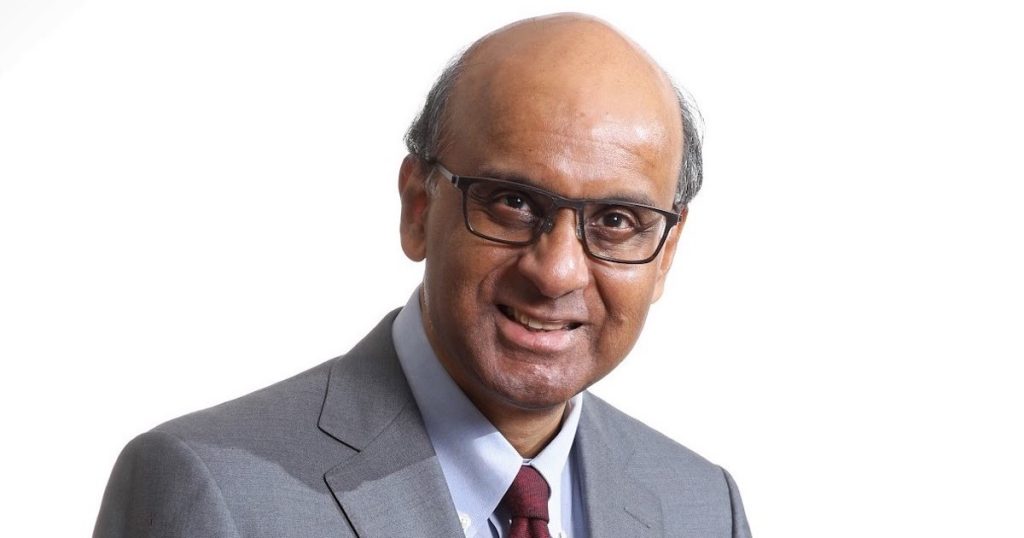
The Monetary Authority of Singapore (MAS) clarified yesterday (July 4) the regulator’s position on cryptocurrency platforms in Singapore.
In a written response, Tharman Shanmugaratnam, Senior Minister and minister-in-charge of MAS, warned that cryptocurrencies are not suitable for investments for the retail public, given the tendency for their prices to swing sharply.
He also argued that recent events have demonstrated the risks of such investment, with the prices of cryptocurrencies falling drastically.
In addition, Tharman also stated that while Digital Payment Token service providers are regulated under the Payment Services Act, the act also allows MAS to impose additional measures on these service providers to ensure better consumer protection, maintain financial stability, and safeguard the efficacy of monetary policy.
In response, MAS has been carefully considering the introduction of additional consumer protection safeguards.
These may include placing limits on retail participation, and rules on the use of leverage when transacting in cryptocurrencies. Given the borderless nature of cryptocurrency markets, however, there is a need for regulatory coordination and cooperation globally. These issues are being discussed at various international standard setting bodies where MAS actively participates.
– Tharman Shanmugaratnam, Senior Minister and minister-in-charge of MAS
MAS has also been active in attempting to prevent crises from developing by attempting to limit retail investment into cryptocurrencies. Cryptocurrency ATMs have been removed from public spaces, and MAS has stated that cryptocurrency service providers should not market or advertise their services in public areas.
The warning by MAS comes as the cryptocurrency industry is under increasing scrutiny amid a recession in the industry. Many companies have been cutting their headcounts, and several high profile companies are also facing crises.
Singapore-based Terraform Labs, which created the Terra-UST and Luna tokens, collapsed two months ago, and this was followed by the implosion of the Singapore-based hedge fund Three Arrows Capital. Three Arrows Capital has since filed for bankruptcy, and MAS last week also censured the company for exceeding the amount of money it was allowed to manage.
These crises have also resulted in another Singapore-based crypto lending platform, Vauld, suspending withdrawals.
As a result, MAS has reiterated its warning that cryptocurrencies are highly risky and unsuitable for the retail public.
“People can lose most of the money they have invested, or more if they borrow to purchase cryptocurrencies,” cautioned Tharman.
Featured Image Credit: Monetary Authority of Singapore
Also Read: Civilising crypto: Why the crypto world needs a legal framework for disputes moving forward
Why this ex-Uber CEO decided to start a M’sian arm of his global cloud kitchen network
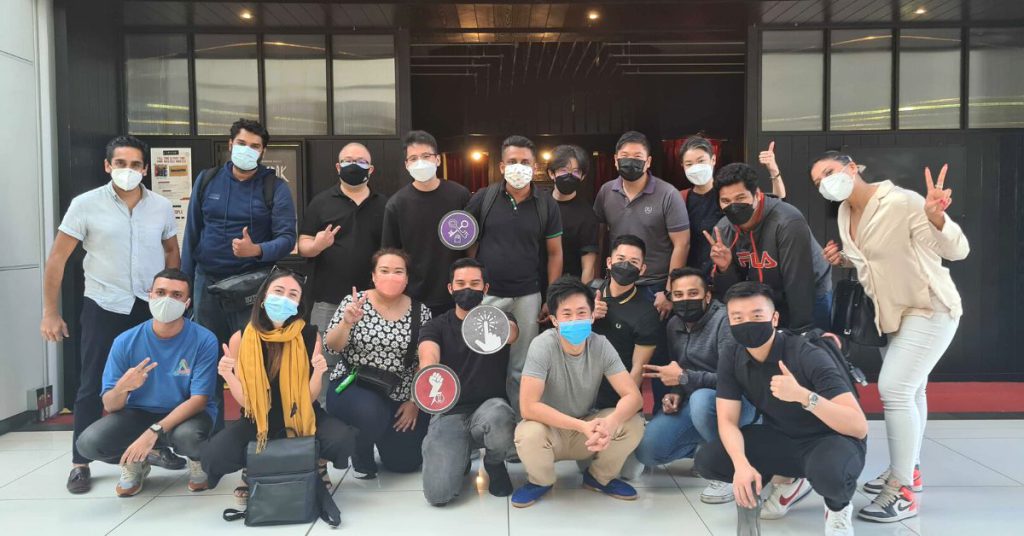
There’s no question that foodpreneurs mushroomed amidst the lockdowns.
Since then, many of them have expanded out of their home kitchens and into cloud kitchens. Given full access to the facilities found in real-life commercial kitchens, foodpreneurs are equipped to fulfil more orders, in turn expanding their operations.
KitchenConnect wants a slice of the cloud kitchen pie. Having begun its Malaysian operations in 2020, the brand is a part of Travis Kalanick’s—a co-founder and former CEO of Uber—CloudKitchens business.
Now, KitchenConnect is present in four locations with 112 kitchens across Klang Valley.
“Our facilities are optimised for delivery whereby each operator gets a kitchen equipped with basic infrastructure with no front of the house,” said Arin Aghazarian, KitchenConnect’s General Manager.
“This reduces the upfront CaPex (capital expenditure) cost of building a whole restaurant including exhaust, aircon, plumbing, design and also, your OpEx (operating expenses).”
Cultivating a melting pot
CloudKitchens is a registered trademark and a brand that has been established in other countries, while KitchenConnect was created solely for Malaysia.
Arin shared that Malaysia was chosen as the main location for setting up KitchenConnect as the country is well-known for being the melting pot of culture and cuisine, not to mention our locals’ deep love for food.
By now, I’m sure most would get the gist of how cloud kitchens work. But if you’re unfamiliar, they’re essentially a restaurant with no physical storefront for customers to dine in.
Virtual F&B brands using it rely solely on food deliveries via their own website, or through delivery apps like GrabFood, foodpanda, AirAsia food, ShopeeFood, etc. You can read our full explainer piece along with the pros and cons of cloud kitchens here.

Part of KitchenConnect’s business model is aimed at being an incubator to help startups and entrepreneurs grow their businesses in the F&B industry.
They assist F&B brands by solving common problems they may face as an infant brand. These include managing their finances, running stock takes, consolidating data, as well as branding and marketing.
KitchenConnect is present in central locations around Klang Valley, including Mont Kiara, Damansara Jaya, KLCC, and Ampang. “We have about 20-30 kitchens in each location and there is no limit to how many diverse brands can come out of a kitchen,” Arin added.
The cost of rent
As F&B brands don’t own their individual restaurants when using a cloud kitchen, the cost of rent should expectedly be lower when renting a smaller space. To be a KitchenConnect licencee, the expected monthly rent is about RM3,500.
However, based on available information online, the fee is on the higher side of things, as we were able to find other cloud kitchens offering rent as low as RM900 per month.
Although, it goes without saying that each cloud kitchen’s rental cost could differ due to their location, additional services, and more.
Arin pointed to the facilities and services offered by KitchenConnect that are provided to its licencees. In addition, insurance, maintenance of the kitchens, pest control, order management, and interaction with delivery riders are handled by the cloud kitchen.

“The technology that we employ through valuable tools and insightful data can be a game-changer,” Arin explained.
“Through tech, we can predict demand, optimise your business, and increase the return on your investment as well as ensure that all your process from prep to the safe arrival of delivery is streamlined and convenient.”
Consultancy is also provided to KitchenConnect’s licencees to help them scale their businesses.
Case study: FOWLBOYS
With KitchenConnect already managing the backend operations to allow its licencees to focus on their craft, some may argue that marketing independently is essential to a startup’s growth.
Plus, upon expansion, entrepreneurs would generally have plans to open their own restaurants, making such knowledge and experience all the more vital.
Wouldn’t KitchenConnect’s services have limitations for these business founders?
“No. As we have different locations, any F&B brands which started with us at one location, have the flexibility to also be a licencee at any of our other locations and can receive the same support provided,” Arin contended.
She pointed to FOWLBOYS as an example, a brand we’ve featured in its early days when it still operated from home.

“They started with us at our Mont Kiara outlet and then moved to The Grange @ KLCC so that they can cater to more central city markets while opening up their own restaurant in Subang,” Arin elaborated.
Of course, these F&B brands would eventually mature over time, but Arin shared that KitchenConnect will continue supporting entrepreneurs in growing their businesses.
“And we are as hands-on or hands-off as much as the brand wants us to be. We would be very proud if a brand expands with us or independently,” Arin told Vulcan Post.
Arin added that other licencees under KitchenConnect that have grown in popularity include Pasta Ohsem, Sugar Bun, and Purple Monkey.
Expanding the kitchen to expand other brands
In the near future, KitchenConnect is looking to expand its Klang Valley outlets to include Subang and Cheras.
Arin added that for the rest of Malaysia, the team is eyeing prime locations including Penang and Johor as well.

Now that dining in is the norm again, I’ve noticed that several cloud kitchens have adapted to the shift in customer behaviour to offer dine-in spaces for customers.
One of them is homegrown cloud kitchen COOKHOUSE’s Artisan’s Playground, which offers an elevated hybrid kitchen experience by partnering with established F&B brands.
While it appears that KitchenConnect focuses more on working with budding entrepreneurs, increasing their visibility with a dine-in strategy will help the brand remain competitive amidst other cloud kitchens in town.
With our observations on cloud kitchen growth over the past few years, two things are clear: they’re here to stay, and this isn’t even their final form.
Also Read: Almost 7 out of 10 Malaysians are not cleaning their beds properly. This is why you have to.
Featured Image Credit: The KitchenConnect team
When this M’sian isn’t crunching data, he’s crafting leather goods with a local flair
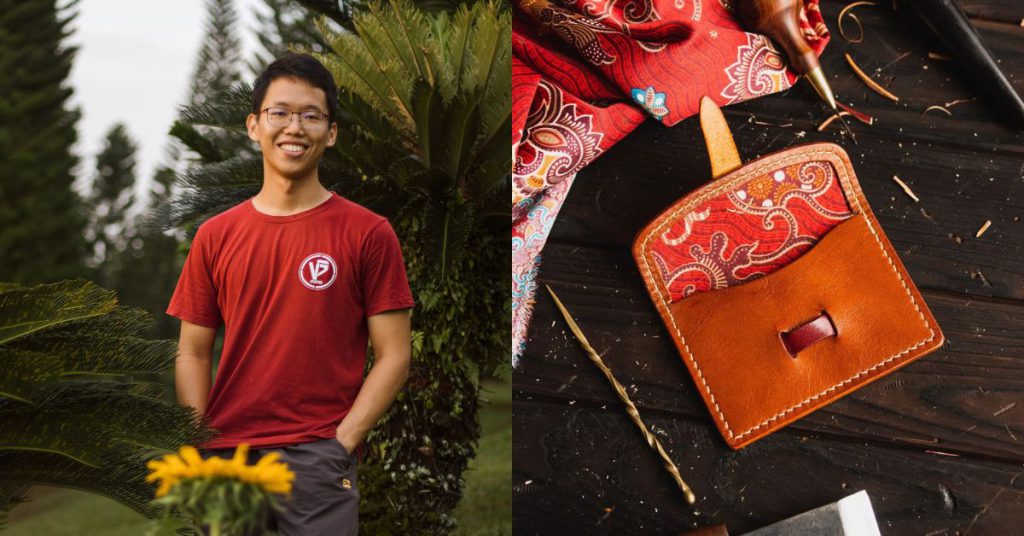
It’s not every day you come across a data scientist who part-times as a leather worker. But today is one of those days.
Benjamin Bong is the 27-year-old behind baba_makes on Instagram. He shares photos of finished leather crafts with his 1.6K followers as well as calming videos of the process.
Personally, I was mesmerised by one of his most-viewed videos—a reel of him crafting a canvas apron with leather pockets. Sounds from his work are overlaid with gentle piano music, and Benjamin’s attention to detail results in a beautiful apron at the end.

Watching Benjamin’s needlework and leathercrafting skills, it was interesting to think that his formal education was in computer science.
Of course, people can have all kinds of hobbies, but Benjamin seems to be pretty serious about his leatherwork. He even has a separate account and brand, Salt & Light Goods, solely reserved to showcase his crafts.
“My degree has not helped me at all in this craft,” Benjamin admitted. “Well, maybe it did by helping me have enough money to explore this craft.”
Learning leatherwork
Benjamin started baba_makes in 2021, but to explain how he got into leather crafting, we’d have to go all the way back to his childhood days. He was home-schooled as a kid, which allowed him to try out various things he was curious about.
“This habit of exploring things and doing things with my hands has never and will never leave me,” Benjamin shared.
As he grew, he became hooked on making his own things, as it gave him the complete freedom to tinker around with the design and functionality of each item. After coming across a few YouTube videos, he ended up taking an interest in leathercrafting.

“Being able to create wallets, book covers, and other stuff exactly how I like them gives me immense satisfaction and pleasure,” he expressed.
Luckily for him, his hobby has been self-sustaining so far. In fact, he hopes to turn leathermaking into his full-time job one day.
“Perhaps not just leather, but to diversify,” he clarified. “The dream is to make a living doing whatever interests me!”
An ode to his culture
When Benjamin first started his account, he wanted it to be a journal of him making whatever he wanted. That’s why he chose the name baba_makes.
“Baba” refers to himself and his Peranakan culture, while “makes” is… well, pretty self-explanatory.

In the beginning, he started out with book sleeves, keychains, and card wallets.
“It was very experimental and based on what I fancied,” he explained. “I would find inspiration from others online, copy the design and functional elements from here and there, and combine them with my own creations.”
Nowadays, he’s focusing to create well-developed designs. This is so that he can produce made-to-stock products as opposed to creating custom orders all the time, a strategy that will help him as he builds his brand, Salt and Light Goods.
“I have zero business and e-commerce experience,” he shared. “I’m flying blind, figuring things out as I go. Starting a brand is just something that I felt was necessary if I were to make this my full-time job. I just wanted it, so I guess that gave me the confidence to start a brand.”

One unique design from baba_makes I’ve noticed is his leather wallets with batik lining on the inside. According to Benjamin, he was inspired by someone else who used fabric lining in their wallets, but he wanted to add a Malaysian twist to it.
He sources all his materials from local suppliers, including the batik fabric.
Keep on making
These days, Benjamin spends half the day as a data scientist, and the rest as a leather worker. Thankfully for him, his boss is flexible enough to let him pursue his passions on the side while keeping his monthly income.

While baba_makes is still a part-time pursuit for Benjamin, his goal to do whatever he likes full-time is steadily gaining traction, despite the many other leathercrafting brands out there.
“The world is a big place,” he mused. “I think each crafter has their own market to serve. I think it’s a good thing to see more crafters in the hobby, as it will mean more are finding joy in working with their hands. It means less digital time and more analogue creations.”
As such, Benjamin hopes to continue finding joy with his crafts, and one day be known for creating quality products that will last a lifetime.
Also Read: As the first OPPO phone to collab with Hasselblad, is the Find X5 Pro worth the hype?
Featured Image Credit: Benjamin Bong, creator of baba_makes
Part 1: Market crash or discount deals? Why now’s the time to learn about blockchain and crypto

Over the past few years, there has been an exponential increase in the users of blockchain technology. Since 2016, the number of people holding crypto assets on exchanges and wallets has shot up from five million to over 200 million.
There is, however, a huge disparity between those who have adopted blockchain technology and those who understand it. If you’re reading this, you’re still early and there’s plenty of time to get ahead on your crypto knowledge. There’s even evidence to prove it.
Studies suggest that as many as 98 per cent of crypto users don’t understand basic crypto concepts. When surveyed, a majority of users have asserted that ‘blockchain’ and ‘Bitcoin’ are synonymous terms or admitted to being unaware. And yes, they are absolutely two different things.
This becomes particularly apparent during times of market downturn, like what we’re witnessing now. For those constantly chasing the hype around the latest memecoins, the bear market may have little to offer. On the other hand, some may realise time off the market may be the prime time to educate and finally actually understand what they are investing in.
Learning about the blockchain can indeed seem intimidating for a beginner. There’s a lot of technical jargon floating around, and it’s tough to separate the significant details from the fluff.
This is why we’ve put together this explainer with Luno’s crypto education hub – Luno Discover, which breaks down everything you need to know about blockchain and its relationship with the crypto ecosystem, in simple terms, to aid your understanding.
The birth of blockchain
Before getting into what blockchain is, it’s important to set some context around why it came to be.
Between 2008 and 2010, the great financial crisis led to the failure of over 300 banks. This caused consumers to lose trust in the banking industry’s ability to manage money.

It became apparent that banks had significant power to mismanage funds and could do so without the knowledge of their investors.
During this time, the blockchain technology – although theorised in the 1990s – saw its first practical use as a system to facilitate transactions without the need for an intermediary (i.e. a bank). This way, people could keep control of their funds at all times and still be able to transact with ease.
Bitcoin was the first form of electronic cash, also known as digital currency, to make use of the blockchain technology. With Bitcoin, people would be able to directly exchange value with each other over the internet, without the need for a ‘middleman’.
How does blockchain technology work?
A blockchain maintains a record of transactions, much like a bank would, but it eliminates any risk of deviation or human error. This is because each transaction is verified by multiple nodes (read: computers) as opposed to one intermediary.
For example, in the case of Bitcoin, it is estimated that there are over 40,000 Bitcoin nodes in existence today.
Transactions are only recorded on the blockchain if a majority of these nodes accept that they are legitimate. This ensures that the record can’t be falsified.

Once a transaction has been recorded on a blockchain, it can’t be altered or deleted. It’s also impossible to make a crypto transaction without it being recorded on a blockchain.
So for every Bitcoin that exists, there is a record of all the transactions which it has been used in. This record is publicly available and can’t be manipulated by any individual.
This blockchain technology is also used as the foundation to create other cryptocurrencies that you might know such as Ethereum.
Why is this a big deal?
By ensuring that transactions are irreversible once recorded, blockchain technology removes the need for mediating any disputes and ensures transparency in monetary operations
Banks have to deal with problems such as chargeback claims and accounting errors, sometimes due to human error, which lead to an increase in operational costs. Ultimately, these costs also flow to consumers in the form of fees, which can get extremely high – especially when sending money across borders.
With blockchain technology, users enjoy consistently low transaction fees and much faster processing times too. While international bank transfers can take up to five days, crypto transactions can usually be processed within minutes.
Crypto apps today allow the seamless transfer of funds, and some have even introduced debit cards which can be used to make real-world purchases around the globe.

For businesses, accepting crypto payments means providing a cheaper payment alternative to avoiding credit card processing fees, which can be as high as five per cent per transaction. In Singapore, restaurants and bars such as Maison Ikkoku and Joo Bar now allow customers to pay using crypto.
Blockchain beyond finance
Although it’s primarily known for its financial utilities, blockchain technology offers a lot more than that.
Any form of transaction can be recorded on a blockchain, not only monetary ones. This opens up a whole realm of possibilities in areas such as collectibles, supply chain management, and voting systems.
With non-fungible tokens (NFTs), blockchain technology is used to verify the authenticity of digital files and its historical transactions – who created them, who were its past owners, to who currently owns them. These can range from artwork and videos, to graduation certificates and medical prescriptions.
As NFT art has become popular, scammers have attempted to sell fake copies of popular works. It’s up to buyers to do their own research and ensure that their purchases are legitimate. They can do so by tracing historical transactions all the way back to the wallet of the NFT creator.

Blockchain technology can prove useful in the management of complex supply chains as well.
For example, Walmart sends out thousands of shipments a day while working with a number of different transport providers.
Typically, the company would have to manually keep track of shipments and process payments. This process was not only expensive and time-consuming, but it would also lead to delays. Using blockchain technology, Walmart is able to synchronise all its logistics and implement an automated payment system instead.
Finally, using the blockchain for voting is another use case that has been gaining popularity.
From reality TV shows to global elections, rigged voting scandals come up all the time. Blockchain can help avoid this by ensuring transparency. Each vote gets recorded as a transaction and can be viewed and verified by all.
The rise of Web3
All of these use cases, when put together, are contributing to the emergence of Web3. While crypto is changing the world of finance, Web3 is using blockchain technology to do the same to the internet.
Currently, in the Web2 world, websites are hosted on a single server. The owners of these servers have access to user data and get to control which users are allowed to use their services.
In contrast, Web3 involves storing data across a network of computers (think nodes in the case of Bitcoin). No individual has the power to restrict access to these apps.
Take social media, for example. While Instagram and Twitter are able to moderate the content posted on their platforms, there would be no such censorship controlled by a centralised authority in the Web3 world.

It remains to be seen whether Web3 is here to replace Web2, or if the two will coexist in harmony. However, one thing’s for sure: the internet will never be the same again.
This is only the beginning of a six-part series which will help you navigate the world of crypto, NFTs, and blockchain with ease. While you wait for the next edition, head over to Luno Discover for some no-jargon learning and should you like bite-sized education pieces, subscribing to Luno’s Telegram channel and following them at @luno_sg on Instagram might suit your needs better.
This article is part of a six-part series to a no-hype beginner’s guide to crypto. You can check out the other articles here:
– Part 2: Types of coins and its risks
– Part 3: NFTs, GameFi, DeFi
– Part 4: Stablecoins
– Part 5: How to ‘DYOR’
– Part 6: Free crypto tools
This article is written in collaboration with Luno.
This partnership between Vulcan Post and Luno is for educational purposes only. Luno Singapore has been awarded in-principle approval from the MAS under the Payment Services Act 2019. Cryptocurrency is a high-risk investment. The value of cryptocurrency can fluctuate significantly and you may lose the capital you invest. Before investing, we urge you to educate yourself about cryptocurrencies and to familiarise yourself with the risks involved, which are detailed in Luno’s Risk Warning.
Featured Image Credit: Deloitte via Quartz
Also Read: Just got started on crypto? Here are the top 5 mistakes made by S’porean beginners





